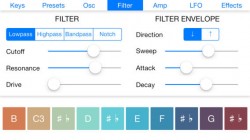 Developer Daniel Resnick has released Synthecaster – a new software synth that fuses elements from guitars and keyboards into a full range polyphonic instrument. According to Resnick, Synthecaster ‘fits on a mobile screen, yet allows for technical playing styles such as shredding and complex chord formation’.
Developer Daniel Resnick has released Synthecaster – a new software synth that fuses elements from guitars and keyboards into a full range polyphonic instrument. According to Resnick, Synthecaster ‘fits on a mobile screen, yet allows for technical playing styles such as shredding and complex chord formation’.
Features:
- Keys are arranged in string-like rows (tuned in perfect fourths by default)
- Sliding across keys in a row results in legato sliding or portamento gliding from note to note
- Sliding a key up or down will bend its pitch in the same direction
- Several notes can be played on the same row simultaneously
- Up to 5 notes can be played simultaneously
- The entire keyboard spans over 6 octaves (not including the range added by oscillator tuning)
Synthecaster’s audio is generated by a highly configurable polyphonic synth engine:
- Dual oscillators with individual tuning
- Filter with envelope sweeping
- Amplifier ADSR envelope
- Soft clip, hard clip, bitcrush, and downsampling distortion
- LFO assignable to amplitude, filter cutoff, or oscillator tuning
- Stereo flanger, chorus, and delay effects
- Over 30 preloaded synth presets
- Create custom presets and share them using AirDrop, Messages, or Mail
- High quality 44.1 kHz stereo audio output
- Audiobus compatibility
Here’s an unofficial demo video, via thesoundtestroom:
Synthecaster is available in the App Store.
If you’ve used Synthecaster, leave a comment with your thoughts on it!

My 3rd gen iPad does not have enough tough sensitivity to “shred” anything, at least not in real time.
It is totally possible to “shred” on an iPad, and this doesn’t video demonstrate what is possible at all. This layout lets you arpeggiate and play chords far better than can be done on an ipad piano layout. It also allows for fretless/microtonal possibilities.
The app developer just needs to get latency/jitter down into around the 10ms range for it to work (and I haven’t tried this particular app yet, so I don’t know if it’s responsive like that). For some reason, a lot of devs ship with 50+ ms of latency (approaching unplayable). Other tricks such as having each row be its own mono voice helps to play extremely fast (ie: legato per string, while chording across strings).
I have shipped three iOS apps that are kind of similar to this (and made a personal one for very large windows touchscreens), and playability is definitely the main strength (i focused on speed/playability and didn’t focus too much on internal sound engine in my case, because it could send midi). iFretless has a similar layout too.
(oh, and I did this on iPad1 …. the iPad3 has far, far, far more responsiveness than the iPad1. it’s possible, but takes some serious restraint in not larding up the interface with animations and bitmaps, and write things the hard way – opengles2 straight to the hardware and completely ignore Apple’s nice user interface. the nice user interfaces allocate/free memory and causes stalls all over the place.)
“I have shipped three iOS apps that are kind of similar to this”
You did not only shipped three IOS apps similar to this, you have set up the foundations of the best methods to perform music on touch screens, something I think should be a standard which every apps should use.
To me, you are the king of musical layouts for touch screens, no less.
We’re not worthy! We’re not worthy!
We are entering a new age; the age of shredding via rubbing.
Shrubbing.